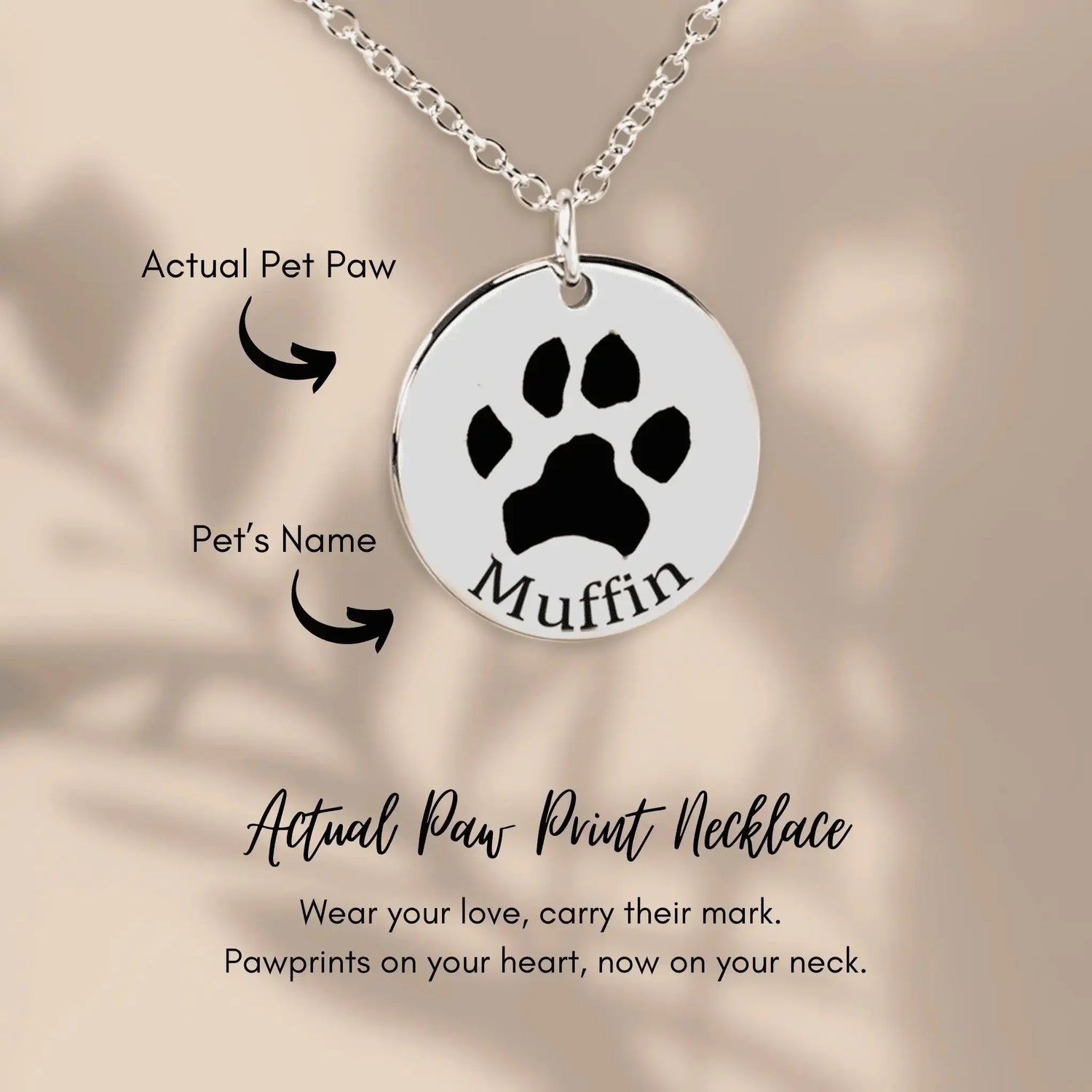10 Paw-some Cat Care Tips for Beginners in 2025
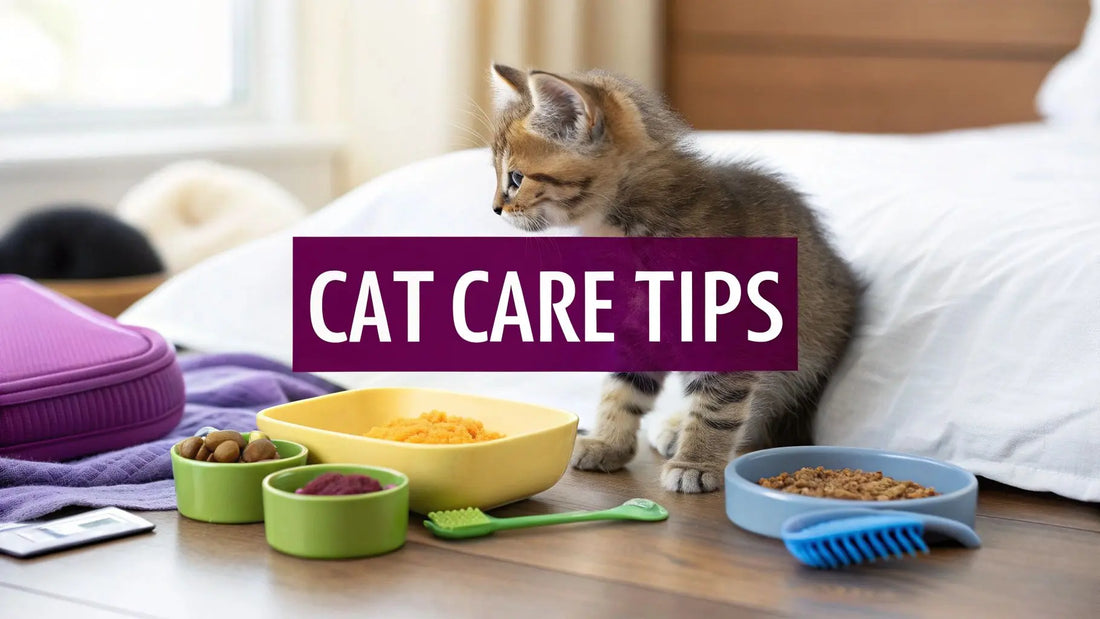
OMG, congrats on your new furry overlord! 😻 Becoming a cat parent is one of the most rewarding adventures, but it can feel like you're trying to read a tiny, fluffy, mysterious book written in a language of blinks, meows, and tail flicks. Don't you worry! Our official mascot, Floofie, has been sniffing out the absolute best secrets to feline happiness, and we're here to translate them for you. 🐾
This isn't just another generic list. We've compiled the ultimate guide of 10 essential cat care tips for beginners to help you navigate this exciting new journey with confidence. Think of it as your roadmap to becoming the best cat parent you can be, covering everything from nutrition and vet visits to decoding that weird chirping sound your cat makes at birds. Floofie is here to show you how to set up the perfect cat-friendly home, maintain a pristine litter box (yes, it's possible!), and build an unbreakable bond with your new best friend.
From creating a stimulating indoor kingdom to mastering the art of the perfect chin scratch, we'll turn you into a pro cat parent faster than you can say 'pspsps'. Let's dive in and get you and your new bestie started on the right paw! ✨
1. Serve Up a Feast Fit for a Feline King or Queen 👑
What's on the menu for your new furry overlord? When it comes to cat care tips for beginners, nutrition is the absolute cornerstone of a happy, healthy life. Cats are obligate carnivores, which means they are built to get their nutrients from meat. As our resident feline expert, Floofie, always says, "A well-fed cat is a happy cat," and that starts with high-quality food rich in protein. 🍗
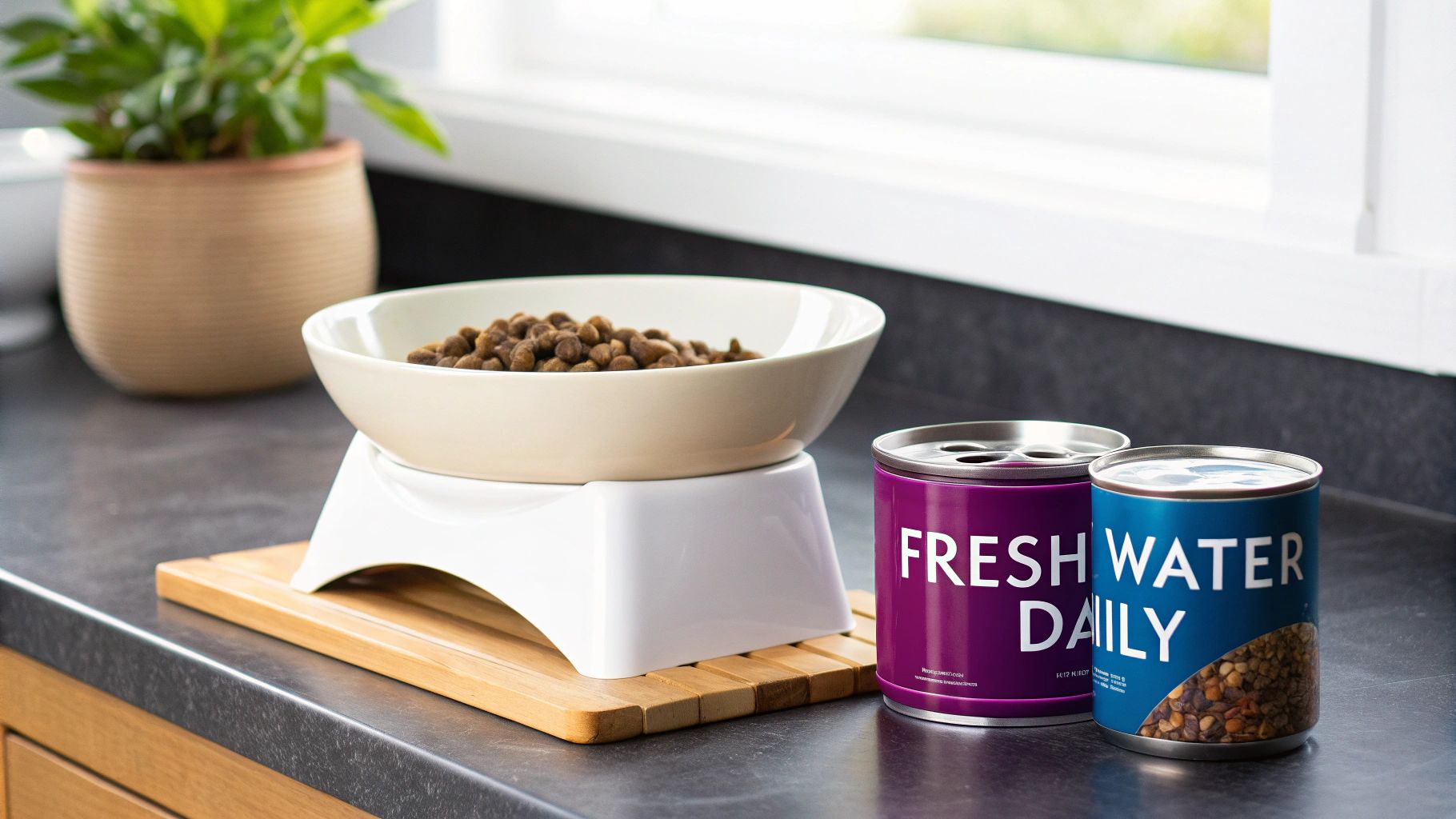
This means serving food where a named meat source like "chicken" or "salmon" is the first ingredient. Also, keep an eye out for taurine, a crucial amino acid cats can't produce themselves. Alongside a purr-fectly balanced diet, constant access to fresh water is non-negotiable for their kidney health. Floofie thinks a mix of wet and dry food often works best, providing both hydration and dental benefits.
Pro-Tips for Feline Feasts:
- Hydration Station: Many cats are picky drinkers. A water fountain, like those from Catit, mimics running water and encourages them to drink more. 💧
- Elevate Their Dining: Reduce neck strain and improve digestion by using stylish, elevated bowls. We adore the ones from our friends at FloofChonk!.
- Feeding Schedule: Stick to a routine. Feed adult cats twice daily, while energetic kittens will need smaller meals three to four times a day.
- Check the Label: Brands like Royal Canin and Hill's Science Diet are formulated based on veterinary science and are great places to start. Always consult your vet to tailor a diet specific to your cat's needs.
2. Set Up a Clean Litter Box and Maintain It Regularly 🚽
One of the most crucial cat care tips for beginners involves mastering the art of the litter box. Cats are impeccably clean creatures, and a pristine "bathroom" is non-negotiable for them. As our mascot Floofie wisely purrs, "A happy cat has a clean potty," and ignoring this can lead to behavioral issues like urinating outside the box and even health problems. A well-maintained litter box is the foundation of a happy, hygienic home for you and your kitty. 💖
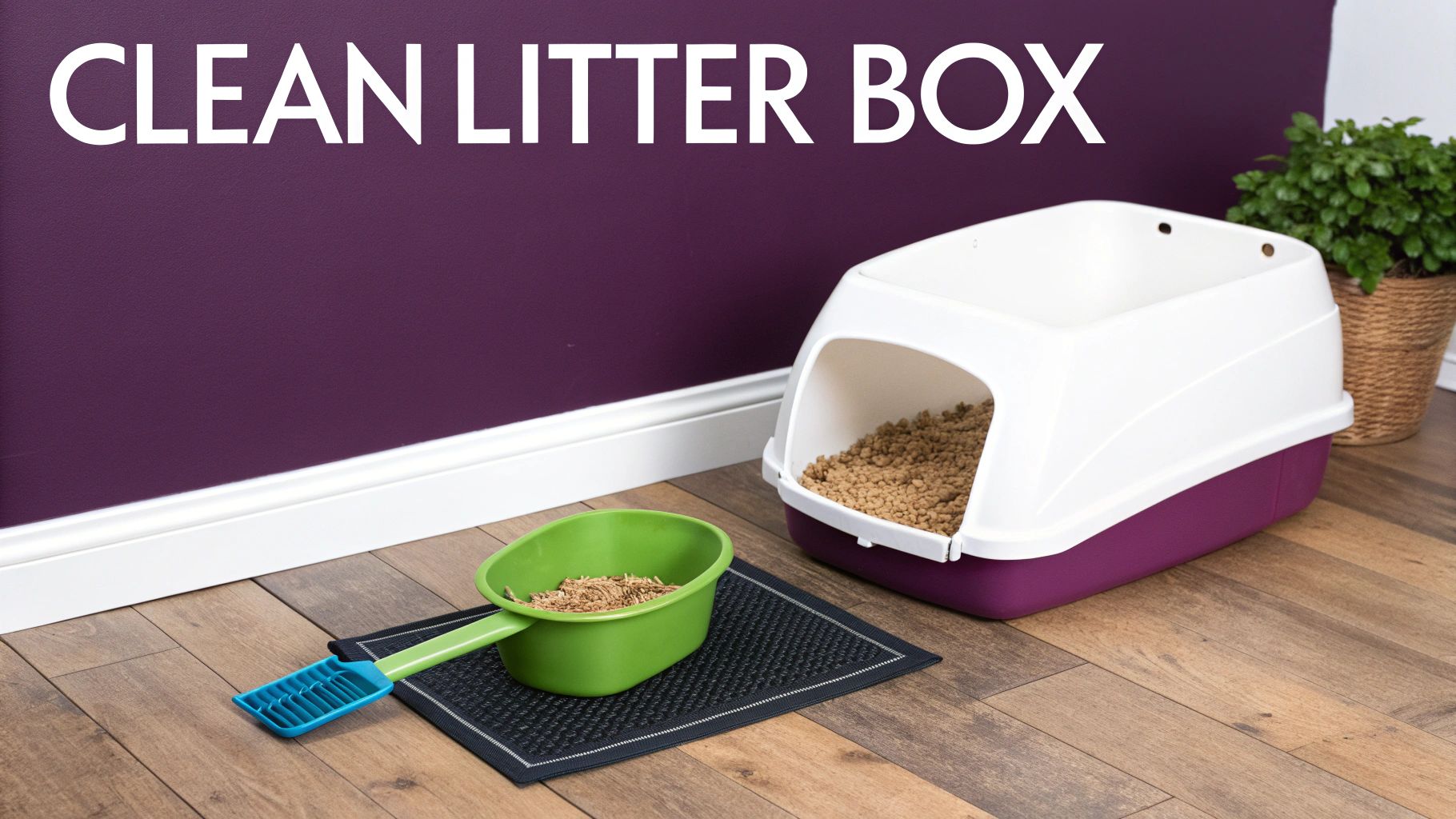
This means providing a safe, accessible, and consistently clean space for your cat to do their business. Think of it as their private sanctuary. The location should be quiet, low-traffic, and well away from their food and water bowls, because Floofie says no one likes to eat in their bathroom! A clean box prevents the spread of parasites, reduces odor, and shows your cat that you respect their fastidious nature, strengthening your bond.
Pro-Tips for the Purr-fect Potty:
- The Golden Rule: Follow the advice of cat behaviorist Jackson Galaxy and have one litter box per cat, plus one extra. This prevents territorial disputes in multi-cat homes.
- Scoop, Scoop, Scoop: Make scooping a daily ritual, ideally twice a day. A full litter change and a scrub of the box should happen at least once a week.
- Location, Location, Location: Place boxes in easily accessible but private spots. Avoid tucking them away in a noisy laundry room or a hard-to-reach basement corner.
- Upgrade Your Setup: For ultimate convenience, consider a self-cleaning marvel like the Litter-Robot. For sensitive sniffers, a quality unscented litter from a brand like Dr. Elsey's is a fantastic choice.
3. Schedule Regular Veterinary Checkups 🩺
Think of your veterinarian as your cat's personal health detective and a key partner in their nine lives. Among the most crucial cat care tips for beginners is establishing a routine of regular vet visits. These aren't just for when your kitty is sick; they're the foundation of preventive care, catching potential issues before they become serious problems. As our wise Floofie purrs, "A checkup a year keeps the big worries away!" 👩⚕️
Annual wellness exams allow your vet to perform a full physical, keep vaccinations up-to-date, and run baseline bloodwork to spot early signs of disease. For kittens, visits are more frequent (every 3-4 weeks until 16 weeks old) to complete their initial vaccine series. Senior cats (7+ years) also benefit from twice-yearly checkups to monitor for age-related conditions like kidney disease or arthritis.
Pro-Tips for Purr-fect Vet Visits:
- First Week Check-In: Schedule your first vet appointment within a week of bringing your new cat home to establish a health baseline.
- Carrier Comfort: Make the carrier a safe space, not a scary one. We love the comfy, stylish carriers from Sherpa that make travel less stressful.
- Ask Away: This is your time! Ask your vet about everything from spaying/neutering and parasite prevention to nutrition and behavior.
- Budget for Health: Factor in the cost of annual wellness exams, vaccinations, and potential emergency care as part of responsible pet ownership. The American Veterinary Medical Association (AVMA) provides excellent resources for new owners.
4. Make the Responsible Choice: Spay or Neuter Your Feline Friend ✂️
Taking on the role of a cat parent includes making important health decisions, and spaying or neutering is one of the most significant. As our wise mascot Floofie purrs, "A 'fixed' cat is a friend for life!" This common surgical procedure, spaying for females and neutering for males, is a cornerstone of responsible pet ownership. It prevents unplanned litters, which helps reduce pet overpopulation, and offers major health and behavioral benefits for your fur baby. 😽
This vital procedure can dramatically lower the risk of certain cancers and uterine infections in females, while neutered males are less likely to spray urine to mark territory or roam in search of a mate. Many behavioral issues, like aggression and yowling, can also be curbed. Most vets recommend the procedure around 4-6 months of age, so it's a key topic to discuss during your kitten’s first check-ups.
Pro-Tips for a Smooth Snip:
- Recovery Cone of Courage: Your cat will likely need an e-collar (the dreaded "cone of shame") to prevent them from licking their incision. Make it a positive experience with a comfy, soft version like the ones from All Four Paws.
- Create a Recovery Suite: Set up a quiet, calm space for their recovery. Restrict high-flying acrobatics by limiting access to tall cat trees and furniture for a week or two.
- Monitor the Incision: Keep a close eye on the surgical site for any signs of redness, swelling, or discharge, and contact your vet if you have any concerns.
- Financial Planning: The cost can vary. Organizations like the ASPCA offer databases of low-cost spay/neuter clinics to make this essential care accessible.
5. Create a Safe and Enriching Indoor Environment 🏰
Transforming your home into a feline wonderland is a key part of our cat care tips for beginners. An indoor cat’s world is only as big as you make it, so preventing boredom is crucial for their mental and physical health. As our chief fun officer, Floofie, advises, "A cat’s home is their kingdom; make it worthy of their greatness!" This means creating a safe space that also satisfies their natural instincts to climb, scratch, hide, and hunt. 😼
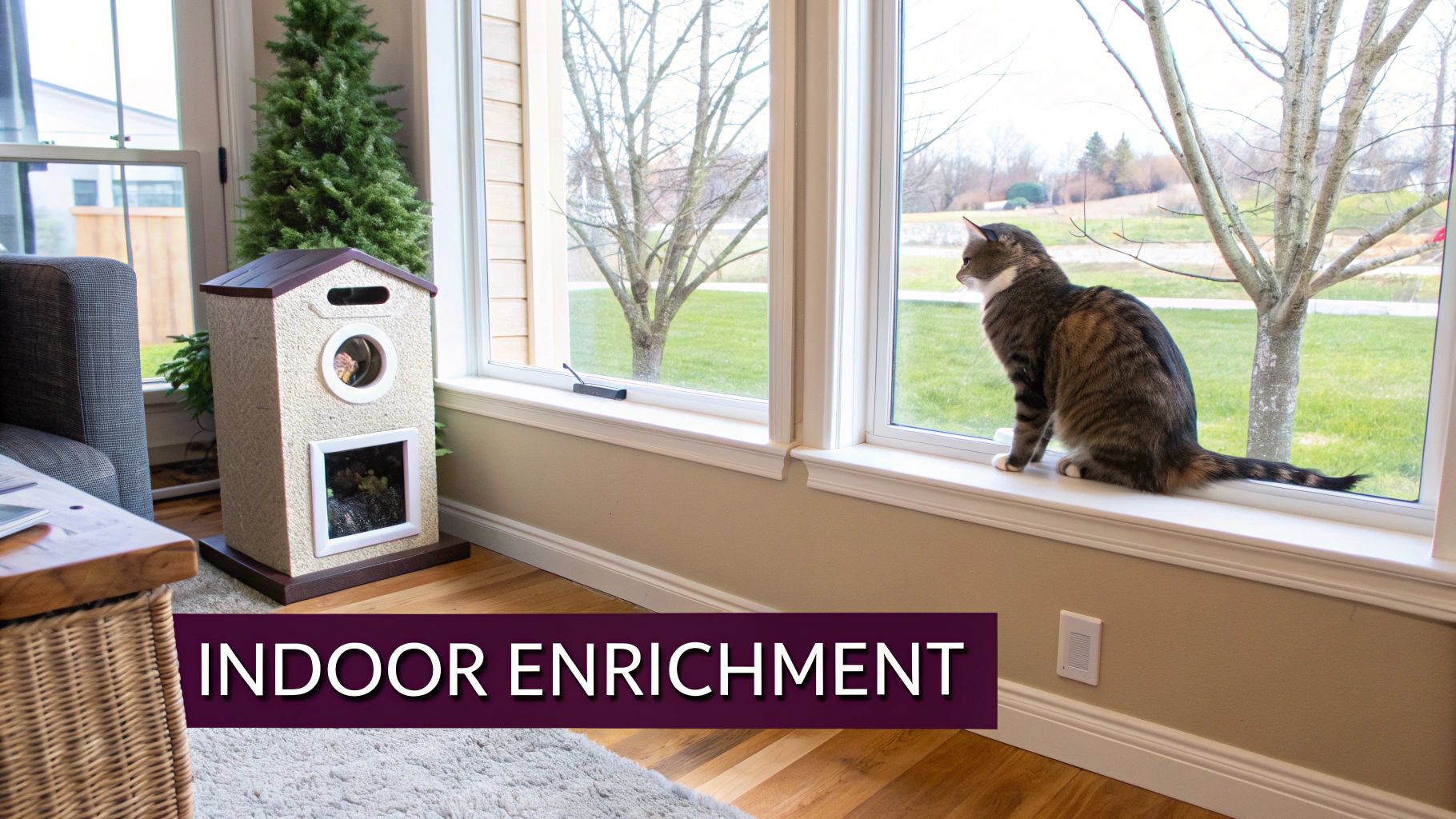
This "catification" process, a term popularized by cat behaviorist Jackson Galaxy, involves enriching their environment with vertical spaces, stimulating toys, and cozy retreats. When designing your cat's funhouse, understanding the principles of space planning can help you create a functional and safe environment. Think of it as interior design, but for your tiny tiger!
Pro-Tips for a Cat-tastic Kingdom:
- Go Vertical: Cats love to survey their domain from above. Multi-level cat trees from brands like CatsPlay or stylish wall shelves from Catastrophic Creations are fantastic options to create a "cat superhighway."
- Window to the World: A window perch, like the popular Sunny Seat, provides endless entertainment (or "cat TV") as they watch birds and squirrels.
- Rotate the Toys: Keep things fresh by rotating toys weekly. Puzzle feeders and feather wands are great for interactive play sessions, which should happen for at least 15 minutes daily. Need more ideas? Learn more about how to keep your indoor cat entertained.
- Safety First: Cat-proof your home by securing loose wires, storing chemicals safely, and checking that your houseplants are non-toxic to felines. A secure home is a happy home
6. Handle Grooming and Nail Care Properly 💅
While cats are meticulous self-groomers, they often need a helping paw to look and feel their best. Proper grooming is a key part of our cat care tips for beginners because it prevents painful mats, reduces shedding, and strengthens your bond. As our spa-day enthusiast, Floofie, reminds us, "A pristine coat and perfect 'meow-nicure' makes for one cool cat!" ✨
Regular brushing maintains a healthy, shiny coat, especially for long-haired breeds like Persians or Maine Coons who are prone to tangles. Nail trims are equally crucial to prevent them from becoming overgrown, which can lead to painful ingrown nails and shredded furniture. It's not just about aesthetics; it's about their health and comfort.
Pro-Tips for Pawsitive Grooming:
- Tool Up: Invest in the right tools. A de-shedding tool from FURminator works wonders for heavy shedders, while a simple metal comb is perfect for long-haired beauties. For nail care, a pair of sharp, cat-specific clippers is essential.
- Start Young & Stay Positive: Introduce grooming sessions when your cat is a kitten. Keep them short, sweet, and always end with treats and praise to build a positive association.
- Nail Trimming Technique: Learn to identify the "quick" (the pink part of the nail with blood vessels) and trim only the white tip. This prevents pain and bleeding.
- Don't Forget the Ears: While grooming, gently check their ears for cleanliness. To learn more, check out our guide on how to properly clean your cat's ears.
7. Understand and Respect Your Cat's Behavior and Body Language 😼
What is your cat trying to tell you? Decoding feline communication is one of the most essential cat care tips for beginners. Cats are subtle communicators, using a complex mix of tail wags, ear flicks, and meows to express their feelings. As our wise mascot, Floofie, purrs, "Listening with your eyes is the secret to a happy cat," and it’s crucial for building trust and a strong bond.
Learning this language prevents misunderstandings that can lead to stress or even a scratch. Recognizing a slow blink as a sign of affection, a puffed-up tail as a warning, or backward ears as irritation allows you to respond appropriately. This respect for their personal space and boundaries makes them feel safe and understood, turning your home into a true sanctuary.
Pro-Tips for Feline Communication:
- Tail Talk: A high, confident tail is a happy cat! A low or tucked tail signals fear. And a furiously swishing tail often means "leave me alone right meow." 🐈
- The Slow Blink: This is the ultimate sign of trust, a "kitty kiss." Slowly close and open your eyes when your cat does it to show you feel the same way. 😉
- Respect Petting Zones: Most cats prefer being petted on their heads and cheeks, where their scent glands are. Avoid the belly unless you have explicit purrmission from the floof!
- Head Bunting: When your cat rubs its head on you, it's marking you as part of its family. We've captured this loving gesture in our adorable Cat Head Bunt Enamel Pin from our friends at FloofChonk!.
8. Provide Appropriate Scratching Posts and Surfaces 🐾
Has your sofa become your kitty's personal manicure station? A key part of our cat care tips for beginners is understanding that scratching isn't naughty-it's necessary! This instinctual behavior helps cats shed the outer layer of their claws, stretch their muscles, and mark their territory. Floofie often reminds us, "A good scratch keeps a cat's paws in prime pouncing condition." 😼
The trick is to redirect that scratching instinct away from your furniture and onto appropriate surfaces. Providing a variety of scratching options is crucial, as different cats have different preferences. Some love to stretch up high on a vertical sisal post, while others prefer the low-to-the-ground satisfaction of a horizontal cardboard scratcher. Offering both ensures you're giving your cat a satisfying and sanctioned outlet for their natural needs.
Pro-Tips for a Scratch-tastic Setup:
- Location, Location, Location: Place scratching posts near your cat’s favorite sleeping spots or next to the furniture they're already scratching. This offers them a better alternative right where they want it.
- Variety is Key: Offer a mix of materials and orientations. A tall sisal post, a corrugated cardboard lounger, and an angled carpet scratcher can help you discover your cat's purr-ference.
- Encourage and Entice: Make the post irresistible! Rub catnip on it, dangle a wand toy from the top, or give treats and praise whenever they use it.
- Get Creative: You don’t always have to buy pre-made solutions. Check out our guide to making a DIY cardboard cat tree for a fun project that your feline will love.
9. Socialize Your Cat and Build Trust Early 🤝
Turning a skittish kitten into a confident companion is one of the most rewarding parts of being a cat parent. Early socialization, especially during the crucial window of 2 to 7 weeks of age, is a fundamental cat care tip for beginners that shapes a well-adjusted adult. This process involves gently exposing them to a variety of people, sounds, and experiences to build a foundation of trust and confidence. As our mascot Floofie purrs, "A friendly hello today keeps the scaredy-cat away!" 👋
This isn't about overwhelming your kitten but creating a world of positive firsts. Gentle handling, hearing the vacuum cleaner from another room, or meeting a calm, cat-friendly dog under strict supervision all count. For older rescue cats with unknown histories, this process is about patience and rebuilding trust, showing them they are finally safe and loved. Building this bond is key to preventing fear-based behaviors and aggression down the road.
Pro-Tips for a Social Superstar:
- Gentle Handling: Start young! Handle your kitten's paws, ears, and mouth gently every day to prepare them for vet visits and grooming.
- Create Positive Vibes: Use tasty treats and fun toys to create positive associations with new experiences. A lickable treat like those from Churu can make vet trips or meeting new people a delight. 😋
- Safe Retreat: Always provide an escape route or a cozy safe space, like a covered bed from our friends at FloofChonk!, where your cat can retreat if they feel overwhelmed. Never force an interaction.
- Patience is Purr-fect: Building trust takes time, especially with a shy cat. Let them approach you on their own terms and reward every small step of bravery. Consistent, positive reinforcement is the secret sauce.
10. Keep Pesky Critters and Ailments at Bay 🛡️
A crucial part of cat care tips for beginners involves playing defense against invisible invaders and common health hiccups. Keeping your feline friend safe from parasites like fleas, ticks, and worms, as well as preventing issues like urinary tract infections, is key to a long and happy partnership. As our wise Floofie purrs, "An ounce of prevention is worth a pound of catnip!" 🌿
This means staying on top of regular veterinary check-ups, vaccinations, and using effective parasite prevention. Think of it as your cat's personal security detail. By proactively managing their health, you're not just avoiding discomfort for them; you're also preventing potentially serious and costly health complications down the road. It's about being your cat's best health advocate.
Pro-Tips for a Healthy, Happy Cat:
- Parasite Patrol: Stay ahead of fleas and ticks with a vet-recommended preventative. Monthly topical treatments like Revolution Plus are fantastic, while a Seresto collar offers long-lasting protection.
- Vaccination Station: Keep your cat's core vaccinations, like the FVRCP booster, up to date. Your vet will create a schedule that's purr-fect for their lifestyle.
- Weight Watching: Obesity can lead to a host of problems. Use a measuring cup for precise portions and encourage playtime to keep them lean and active. We love the laser pointers from our friends at FloofChonk! for a good workout.
- Monitor Mission: Be vigilant for changes in behavior, appetite, or litter box habits. Early detection of any issue is vital. If something seems off, don't hesitate to call your vet.
10-Point Comparison: Beginner Cat Care Tips
| Care Action | 🔄 Implementation Complexity | ⚡ Resource & Time | 📊 Expected Outcomes | ⭐ Key Advantages | 💡 Ideal Use Cases |
|---|---|---|---|---|---|
| Provide Fresh Water and Quality Food Daily | 🔄 Low — daily routine, occasional trials | ⚡ Moderate cost (premium food); minutes/day | 📊 Better hydration, nutrition, urinary & kidney health | ⭐ Prevents deficiencies; supports coat, energy | 💡 All cats — kittens, seniors, picky eaters; use fountains, wet/dry rotation |
| Set Up a Clean Litter Box and Maintain It Regularly | 🔄 Moderate — daily scooping + weekly changes | ⚡ Ongoing litter cost; daily time commitment | 📊 Fewer elimination issues; early illness detection | ⭐ Maintains hygiene; reduces odors and behavioral problems | 💡 Indoor & multi-cat homes; one box per cat + one extra |
| Schedule Regular Veterinary Checkups | 🔄 Moderate — scheduling, travel, tests | ⚡ Higher cost (visits, diagnostics); occasional time off | 📊 Early disease detection; maintained vaccination status | ⭐ Preventive care reduces emergencies; professional guidance | 💡 Kittens, seniors, all cats for annual wellness and vaccinations |
| Spay or Neuter Your Cat | 🔄 Moderate — one-time surgical procedure, 7–10 day recovery | ⚡ Upfront surgical cost; short recovery monitoring | 📊 Prevents unwanted litters; reduces certain health risks & behaviors | ⭐ Permanent population control; lowers reproductive disease risk | 💡 All owned cats; shelters and TNR programs for feral populations |
| Create a Safe and Enriching Indoor Environment | 🔄 Moderate–High — setup and ongoing rotation | ⚡ Variable cost (trees, perches, toys); daily playtime (10–15 min) | 📊 Reduced boredom, stress; improved mental stimulation | ⭐ Encourages natural behaviors; strengthens bond | 💡 Indoor-only cats, multi-cat homes, sedentary cats |
| Handle Grooming and Nail Care Properly | 🔄 Low–Moderate — regular brushing and trims | ⚡ Low–moderate cost for tools; routine time (minutes–hours/week) | 📊 Fewer mats/hairballs; better skin and dental health | ⭐ Early problem detection; bonding opportunity | 💡 Long-haired breeds, heavy shedders, cats prone to mats |
| Understand and Respect Your Cat's Behavior and Body Language | 🔄 Moderate — learning and observation over time | ⚡ Time investment for education and observation | 📊 Fewer conflicts; improved handling and reduced stress | ⭐ Better communication; prevents aggression incidents | 💡 New owners, reactive or fearful cats, multi-person households |
| Provide Appropriate Scratching Posts and Surfaces | 🔄 Low — purchase and strategic placement; some trial & error | ⚡ Low cost to moderate; occasional replacement | 📊 Protects furniture; healthy claw maintenance | ⭐ Redirects natural scratching; inexpensive solutions exist | 💡 Homes with furniture damage, multi-cat environments |
| Socialize Your Cat and Build Trust Early | 🔄 High — consistent early effort during critical window | ⚡ Time-intensive early (2–7 weeks critical), ongoing reinforcement | 📊 More confident, adaptable adult cats; fewer fear behaviors | ⭐ Improves vet handling and adoptability | 💡 Kittens (2–7 weeks), rescue/foster programs, multi-handler homes |
| Prevent and Manage Common Health Issues and Parasites | 🔄 Moderate — scheduled preventive treatments and monitoring | ⚡ Recurring cost (monthly preventives, vaccines); routine checks | 📊 Fewer infections/parasites; longer lifespan, lower emergencies | ⭐ Protects household; reduces transmission and severe disease | 💡 All cats (esp. outdoor, multi-pet homes); follow vet prevention schedules |
You've Got This, Cat Parent! Go Forth and Cuddle 🎉
And that's a wrap! You've officially graduated from the Floofie academy of fantastic feline friendship. We've journeyed through the essentials, from mastering the art of the pristine litter box to decoding those mysterious tail twitches. Navigating the world of cat parenthood can feel like a big adventure at first, but with these foundational cat care tips for beginners, you're more than ready to provide a loving, safe, and utterly delightful home for your new best friend.
Remember, this journey is built on a few core pillars. Providing a balanced diet and fresh water daily is the cornerstone of good health, while regular vet check-ups act as your proactive wellness plan. Creating an enriching indoor world with scratching posts and stimulating toys isn't just about fun; it's about honoring your cat's natural instincts and keeping their minds sharp and happy. You're not just feeding a pet; you're nurturing a tiny tiger! 🐯
Your Feline Friendship Checklist
Let's quickly recap the most crucial takeaways to keep in your back pocket:
- Consistency is Key: Cats thrive on routine. Regular feeding times, consistent litter box cleaning, and predictable playtime sessions help your cat feel secure and loved. This builds a powerful foundation of trust between you.
- Observe and Learn: Your cat is constantly communicating with you through their body language. Paying attention to their ears, tail, and posture will transform you into a cat behavior expert, deepening your bond and helping you meet their needs before they even meow.
- Proactive Health is Happy Health: Don't wait for problems to arise. Spaying or neutering, staying on top of parasite prevention, and scheduling those annual vet visits are the most loving investments you can make in your cat's long-term well-being.
The Heart of It All: Patience and Love
Ultimately, becoming a great cat parent is less about perfection and more about patience, empathy, and a whole lot of love. There will be learning curves, quirky habits to discover, and maybe a hairball or two on your favorite rug. Embrace it all! Every gentle head boop, every rumbling purr, and every sleepy cuddle is a reward for your dedication. You're building a unique, heartwarming relationship that will bring immeasurable joy to your life. So go on, enjoy every moment of this incredible journey. You've totally got this! ❤️
Ready to celebrate your new role as a super-star cat parent? At FloofChonk, we create playful, unique apparel and accessories inspired by the wonderful weirdness of cats just like yours. Check out our collection at FloofChonk to find the purr-fect gear to show off your feline pride
